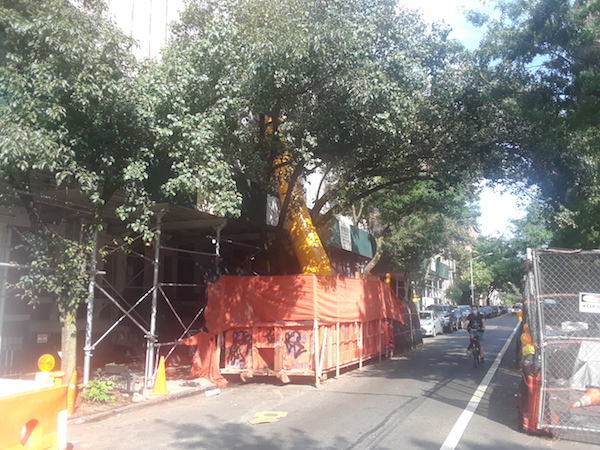
BY WINNIE McCROY | The COVID-19 crisis that wreaked havoc on our city is compounding quality of life problems this summer, as loiterers who use and sell drugs make the streets less safe for those who call West Chelsea home. Now, those residents are reaching out to elected officials for help removing some of the scaffolding and sidewalk sheds where people congregate, sometimes engaging in illegal activities.
“My office has worked hard over the years to eliminate unnecessary and unsightly sheds that have been up for years and aren’t connected to construction, but the city needs to do more. The de Blasio administration must take this seriously, and work with small businesses to provide relief,” said New York City Council Speaker Corey Johnson, who, as District 3 rep, has successfully worked with other community leaders to remove problem scaffoldings in Chelsea.
As of late, the problem has moved to Eighth Ave. btw. W. 20th-22nd Sts. and its accompanying side streets, where individuals are dealing hard drugs, smoking crystal meth on the front stoops of buildings in which they do not reside, injecting drugs, and leaving used syringes in the street. One resident of the 300 block of W. 21st St. has had enough of watching the nearby sidewalk shed used as shelter for drug deals and hookups.
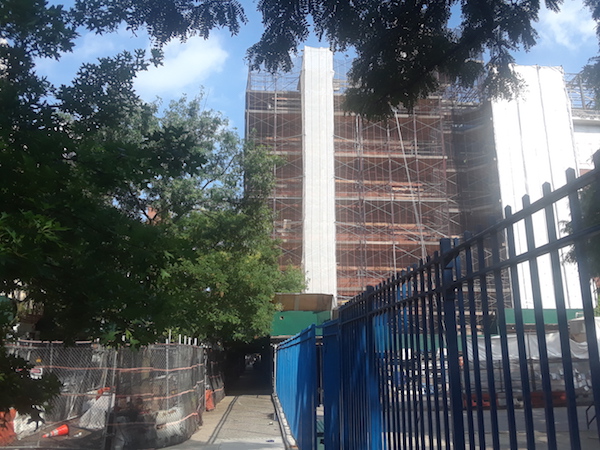
“Everyone on this block is very unhappy about it,” said longtime Chelsea resident Vivek Batra, who has three sidewalk sheds on his block. “Ever since the incidents of people being killed by falling bricks and mortar, there are unlimited permits for sidewalk sheds. The scaffolding [on my block] has been up for a year and a half, and it will be another year and a half before the work is done. And under the scaffoldings any hour, day or night, the homeless are watching porn.”
Said Community Board 4 (CB4) public member and 38-year Chelsea resident Sally Greenspan, “In that particular area, the scaffolding and the LinkNYC [kiosk] tower have a confluence.” (For our recent coverage on that confluence, click here.)
Batra said these street youth sometimes climb the scaffolding in an attempt to burglarize second story apartments. At other times, he said, they engage in sexual activities in vestibules, or steal packages from building lobbies.
Greenspan, who is also an active member of the Council of Chelsea Block Associations, recalled having “always wondered why scaffoldings seemed to always go up, but never come down.”
The reasons, to quote Greenspan’s assessment, are “much more complicated than I’d imagined.” Issues include problems with owners securing bank loans to complete necessary repairs, as well as ancillary issues like delinquent or absentee owners, inclement weather, and, increasingly as of late, the human factor.
John Mudd, who serves as president of the Midtown South Community Council, has been successful in helping an unhoused individual who was using a sidewalk shed located near his residence in the West 30s as a home. He helped the man get stabilized and find housing, but can’t stem the tide through individual effort.
(As noted by Mudd, the term “homeless” is inelegant at best, inaccurate at worst. As such, he suggests, “unhoused” takes into account those who consider city-run shelters unsafe, or choose not to shelter-in-place where they reside, because the domestic situation exposes them to physical or psychological harm.)
“Chelsea has been overwhelmed by sheds,” said Mudd. “There are way too many going and staying up, just being left up. And yes, the unhoused will gather under these sheds to get out of the rain, and set up camp, or whatever.”
This summer seems to be the perfect storm for those seeking refuge under Chelsea sidewalk sheds and scaffoldings.
“These kids aren’t from this neighborhood, and social services should be dealing with it,” said Batra. “I think a lot [of them are] homeless and I feel bad for them, but not worse than I feel about them taking over the neighborhood and doing drugs everywhere.”
Homelessness A Huge Part of the Problem | The proliferation of scaffolding may be irritating, but it seems the behavior of those who congregate underneath it is the real issue that is leaving Chelsea residents at odds, in this oddest of summers.
“It often seems like more scaffolding keeps going up, while existing scaffolding comes down at a snail’s pace, but it’s complicated,” said Greenspan. Local Law 11 inspections and repairs must be made while scaffolding is up, and oftentimes necessary repairs are delayed beyond the control of the building owners, ergo the extended life of the scaffolding. One challenge is to identify the delinquent owners who have either not made repairs in a timely manner or made repairs required by Local Law 11 and still have not removed the scaffolding.
In a Nov. 21, 2019 symposium held by the Chelsea Reform Democratic Club (CRDC), called “Homeless: Challenges, Choices and Crises,” Eric Bottcher, Chief of Staff to New York City Council Speaker Corey Johnson, noted the rising rates of homelessness in the city. (To read our coverage of the symposium, click here.)
“Homelessness went up 23 percent under Rudolph Giuliani. It went up another 70 percent under Michael Bloomberg and it’s gone up, I believe, another 40 percent under Bill de Blasio,” said Bottcher.
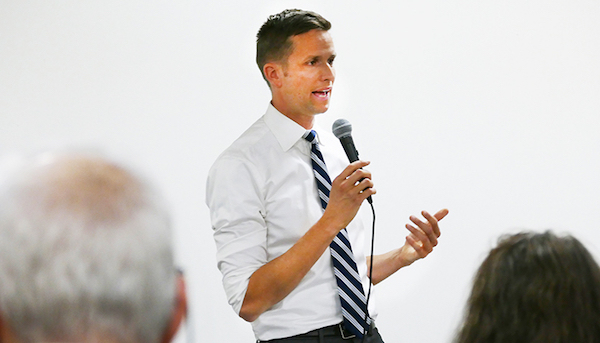
At that symposium, Botcher noted how Speaker Johnson’s office phone had been ringing off the hook with complaints about the homeless and public safety issues in Chelsea. Some of these street people refuse to access the homeless shelter system due to mental health or substance abuse problems, and live in parks or niches, like scaffolding sheds.
Chelsea’s W. 25th St. Bowery Residents’ Committee (BRC) vertical campus facility developed a “Safe Haven” model to try and get these folks into smaller shelters in nearby communities. This plan provides more than 1,800 beds to those in need. But with the COVID-19 pandemic, some of these street people make feel that sleeping outside is safer than mingling with those who are possibly infected. At this point, the BRC is focusing their efforts on homeless in the subway, while groups like Breaking Ground handle local street outreach. They referred Chelsea Community News to the NYC Department of Homeless Services (DHS) for comment. Unfortunately, the DHS did not return multiple requests for comment by press time. Still, the problems continue to mount.
“There is no money coming in from the federal government, so people will soon start being evicted,” said Greenspan. “Some might have families, but they’ll have no job and no money, and they’re going to the streets. It’s going to get a lot worse before it gets better.”
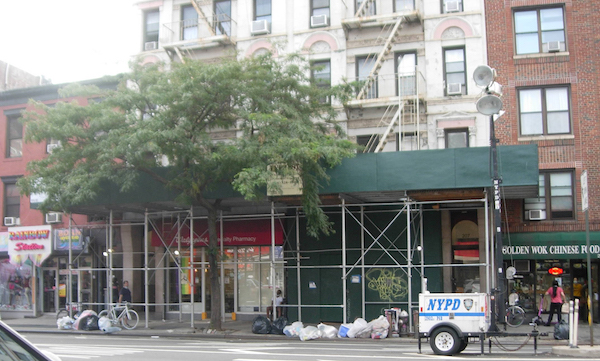
Working With the 10th Precinct | In a recent CCN report, Deputy Inspector Kevin J. Coleman, Commanding Officer of Chelsea’s 10th Precinct, noted Crime Prevention Officer Jarett Dilorenzo had been meeting with building caretakers and owners to recommend better ways to secure their buildings, such as a bolt lock or latch guard. They also recommended building caretakers move packages so they are not within sightline of the front door.
The NYPD also urged residents to be careful who you let into your buildings. Two officers recently arrested a man dressed as a construction worker, who was burglarizing a residential building.
Batra said he had spoken to the police repeatedly about the proliferation of drug dealers and users in front of his building, but there is little they can do because even when they catch them, they’re back out within a few hours.
“They have no respect for the police; at our last meeting, the cops said they told them to ‘fuck off,’” said Batra. “The police’s hands are tied, so I don’t know who to turn to. I’m trying to involve the City Council, but it’s been a year. How long are you going to talk about it before you do something, when it’s getting worse by the day?”
Batra said petty thieves break into his vestibule to steal packages or have sex. He’s seen people smoking crystal meth on his block at 7:30am, and watched drug dealers camped out on a W. 21st St. stoop prevent a man returning from his daughter’s funeral from entering his own home. Batra, a board member of his co-op, keeps a log of the incidences, and relays them to Speaker Johnson, local neighborhood associations, and news outlets in hopes of enacting change.
After repeated incidents of people climbing up the scaffolding toward his second floor window, causing his dog to bark all night long, his building installed motion-detecting lights. In a similar preventative measure, neighbors seem to appreciate an NYPD floodlight at the corner of Eighth Ave. and W. 21st St., installed shortly before the COVID-19 crisis began.
“We had a lot of positive feedback regarding the light tower. It helps illuminate the area, deters disorder, and makes people feel safe. It’s always a good idea to place a light in a dark area, as it can act as a deterrent to crime,” said DI Coleman.
Legislation Would Shortens Stay of Sidewalk Sheds | On Dec. 7, 2016, City Councilmember Ben Kallos’ Introduction 1389-2016: Time Limits for Scaffolding and Sidewalk Sheds sought to regulate the proliferation of sidewalk sheds by mandating that building owners have 90 days to fix a dangerous condition, with an additional 90-day extension allowed.
After 180 days, the City would do the work to correct the dangerous condition, and bill the owner. In addition, work on these building façades could not be interrupted for more than seven days without a mandate to remove the sidewalk shed, or face heavy penalties. But the proposal has yet to receive a hearing.
“I think we’ve got to go much further,” said Mudd. “If these building owners don’t have the money to fix the problems, they sometimes find it cheaper to put up a scaffold and let it sit there for a couple of years.”
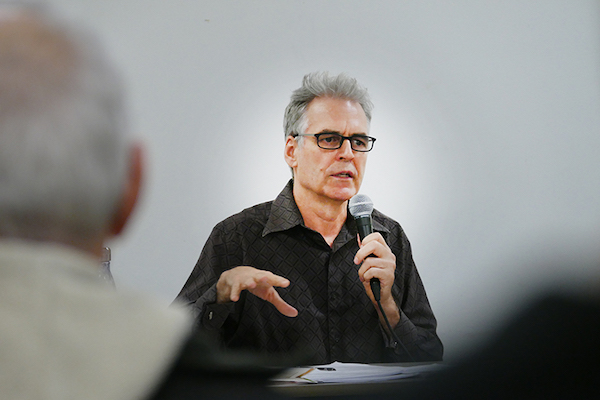
Mudd pointed to a former tenement building down the street from him, where the scaffolding has been up for five years. Mudd suspected the landlord used underhanded tactics to push people out, so he could sell the building to hoteliers, which he did. When Mudd suggested the new ownership build affordable housing, they reportedly said there was “no way they could consider that,” when it would be so much more profitable to add floors, via air rights, and operate as a hotel.
Mudd wanted to hear from the NYC Department of Buildings (DOB) on possible solutions, including how to tighten up regulations regarding the use of scaffoldings, and possibly enact an accumulative fee schedule to give owners a sense of urgency to fix problems, saying, “If you can’t get it fixed in six months, you’re not focused on the job.
Still, scaffoldings pop up like mushrooms after a storm. Crain’s New York reported in January that the DOB doubled down on scaffolding approvals after designer Erica Tishman was killed by a falling chunk of debris in Times Square in December 2019. That incident prompted the DOB to issue a passel of emergency notices for unsafe façades, mandating building owners to quickly erect sidewalk sheds, only adding to the more than 190 miles of current sidewalk sheds (about 9,0000 scaffolds) proliferating city streets.
But Crain’s noted in that article that building owners “sometimes find it cheaper to rent a sidewalk shed than to pay for renovations, leaving some hanging around for years.”
“Ultimately the solution isn’t just to put sidewalk sheds everywhere,” said Kallos, in that article. “We need to get to a place where folks are actually doing the work to maintain their buildings.”
“Nobody’s doing anything,” said Cher Carden, a local resident who is a member of the preservationist group Save Chelsea. “I think there’s only been five days of work done at one of these scaffoldings. I think that legislation could be helpful, because I remember there being scaffolding up for three years where I work, and it was not being used for a lot of that time.”\
Mudd and other community leaders have been working with elected officials to do cleanups and take a proactive approach. Representing the collective voice of the Midtown South Community Council, Mudd wrote a 120-page study (2018’s Homeless and Housing), which highlighted the problems of the unhoused, and how to become involved. In his opinion, people need to worry about more than their own little patch of space, and look at the bigger picture.
“Our society is operating very badly, and we all have to pitch in,” said Mudd. “There are successful examples of those who have conquered this problem. Europeans have done fairly well. So the answer is there. It’s just that our capitalistic system is eating us up from the inside out.”
The success stories are few and far between. In March 2019, AM New York reported that a longstanding sidewalk shed that became a neighborhood eyesore was finally removed at 210 Seventh Ave. at W. 22nd St. The shed was reportedly installed in 2010 to protect from the building’s crumbling façade, after “notoriously negligent owner” Errol Rainess abandoned it.
The DOB records indicate that the building received 115 complaints and 150 violations. They issued a permit for a sidewalk shed on Oct. 21, 2010 and it was installed soon after. But it wasn’t until Feb. 2017 that the DOB ordered the owner to repair the façade, which was in danger of partial collapse.
No surprise, the owner did not comply. So in Oct. 2018, the DOB issued an emergency declaration for the Department of Housing Preservation and Development to remove 35 feet of metal cornice, do repairs to the entire façade and repairs to the sidewalk shed itself. The completed work was inspected and the DOB signed off on Jan. 28, 2019. The scaffolding was taken down a month later—nearly a decade after the saga first began.
Said Greenspan, “With the high level of anxiety that exists, the triumph of getting one scaffolding down, cleaning even one little area, makes a huge difference to the quality of community life. If people feel that the City, our electeds, are paying attention and doing their best to solve problems, it makes a difference.” Greenspan considers every victory as one further step in the right direction, but noted the enormity of the problem “must be addressed, long-term, with effective legislation.”
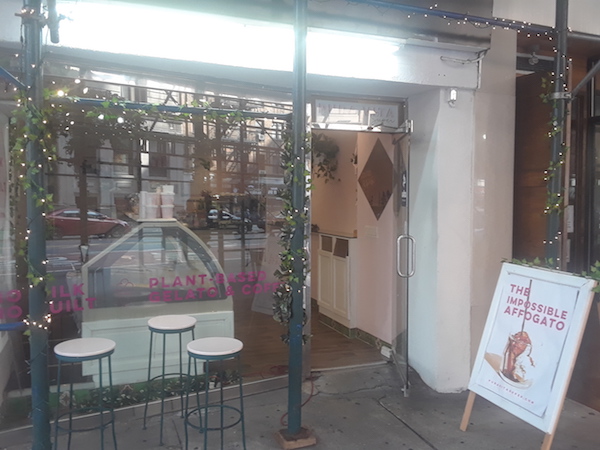
Impact on Small Businesses | Just as they have impacted the quality of life of Chelsea residents, sidewalk sheds have also impacted local small businesses. Longtime Chelsea residents Carden and Andrew Rai were upset when to see their beloved, newly opened plant-based gelato and coffee shop, Pura Vita Super (208 W. 23rd St. btw. Seventh & Eighth Aves.), was struggling to remain open. Next door, the beloved Aristocrat Deli had already shuttered for good, its post-pandemic hopes crushed under the wight of multiple challenges, including the same shedding that was causing trouble for Pura Vita Super. [Seeminlgy one long, uninterrupted shed covering the block all the way to the end of the Chelsea Hotel, that walk of shame is actually the result of sheds that sprung up to cover several construction sites.)
Recently, Carden and Rai met with Bottcher, from Speaker Johnson’s office, to visit these merchants, and inquire as to how the long-term presence of scaffoldings, along with COVID-19, have impacted their businesses.
“I don’t know why the Aristocrat Deli closed, but I think it’s because of the pandemic,” said Carden. “And Pura Vita Super is still talking about having to close. It’s been difficult for them to succeed because of it.”
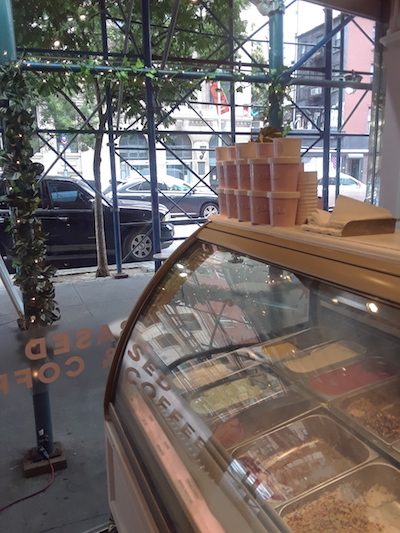
Chelsea Community News’ founder/editor, Scott Stiffler, stopped by Pura Vita Super on Fri., Aug. 14, to lean more about the challenges faced by gelato and coffee-obsessed siblings Federico and Erica Cutroni.
“It was always our dream to bring our authentic Italian roots to New York City, ” recalled the co-founders, on the “Our Story” section of their website, “and we’re all about living the pure life. We hope Pura Vita Super inspires others to live in a healthier, more sustainable way too.”
But their dreams of success, and eventual franchising, got a wake-up call just three days after the store’s Feb. 8, 2020 opening—when scaffolding began to go up, and the resulting sidewalk shed immediately reduced the number of daily customers. (Foot traffic under sidewalk sheds is often of the get-to-the-other-end-quickly pace, and seasoned pedestrians cross the street to avoid the experience entirely.)
“Of course, it was an issue from the beginning,” Federico recalled, noting building management told him the scaffolding was “only going to be up for a month.” Referencing that moment in soccer when the team with the ball puts it between heir own posts, Federico said, of the scaffolding’s unexpected arrival, “From an ‘own goal,’ you start with a minus.”
Open for only three weeks before COVID-19 precautions kept the business closed for two months, Pura Vita Super’s presence in Chelsea remains uncertain.
Carden’s frustration with the devastating impact long-term scaffolding has on local businesses extends to the effect on wary residents faced with the prospect of long “tunnels” running the length of the construction area.
Describing a dilemma experienced by pedestrians all over the city—including those who pass by W. 21st St.’s PS 11—Carden said she gets “a little nervous walking under the scaffolding, because people are living there or hanging out, who might not be in their right mind or might be on drugs at the time. And because of COVID-19, I don’t want to pass by in an enclosed space, because the possibility of aerosolized virus makes it difficult to feel safe under those scaffoldings.”
In an attempt to remedy the losses suffered by businesses located under scaffoldings, Carden hoped local merchants could band together to circulate fliers about the services they offer. She even wished for a makeshift street fair, where vendors could safely peddle their wares in an open-air environment. Unfortunately, the City has put a halt to street fairs this year.
As for the issue of people congregating under scaffolding for long periods of time, noted Mudd, “We’ve had several conversations with business owners about this sort of thing, and when it comes to the unhoused, we definitely have a crisis of not having housing.”
Mudd observed the past half-year has magnified existing conditions. The COVID-19 crisis, he said, “has caused so many programs’ resources to become diminished, and people without housing have not had other resources to stay off the streets during the day. And I don’t think anyone wants to be cooped up in a shelter all day long. So people are going to shelters at night for a place to sleep, but there are very little resources to begin with, and not enough housing.”
Mudd said that the city’s climate of vulture capitalism was to blame—when all that is being built are hotels. “There’s no ‘affordable housing’ when the median income is around $55,000—and I am sure that has changed during COVID-19. ” He added that although people should feel more sensitive to those without housing, “People are very frightened, and many business owners subconsciously know their businesses are not sustainable. But they have a lot invested in them, so they ‘punch down’ sometimes. Just think, if we had that anger focused to the right causes, such as pushing for housing.”
From his point of view, opined Mudd, our collective anger would be better focused on pushing for legislation to ensure rent stabilization and control. But instead, locals live in fear while deep-pocketed “gravedancers” take advantage of fire sale prices to buy properties and wait for their value to increase.
“Everyone was semi-isolated from this, but now that COVID-19 stripped everything away, you can see that this really vivid problem is there,” said Mudd. “Rather than think of it as a ‘homeless’ problem, we need to look at it as a social issue. It’s a social problem—our social problem—and it’s solvable.”
Chelsea Community News is made possible with the help of our awesome advertisers, and the support of our readers. If you like what you see, please consider taking part in our GoFundMe campaign (click here). To make a direct donation, give feedback about the site, or send a Letter to the Editor, email scott@chelseacommunitynews.com.

Pingback: ชีสเค้กทุเรียน
Pingback: Trust bet
Pingback: หวยออนไลน์ LSM99
Pingback: wedding planner thailand
Pingback: lights for cornhole boards
Pingback: เกมออนไลน์ LSM99
Pingback: Samui muay thai
Pingback: psillys magic mushroom gummies
Pingback: SIMPLEPLAY
Pingback: นวดเชียงราย
Pingback: Scaffolding’s Dismantling Clears Path Real and Symbolic Along Troubled Chelsea Corridor - Chelsea Community News
Pingback: Extra resources
Pingback: Ammunition for sale online
Pingback: New fake US passports available
Pingback: voir ce site
Pingback: Arthritis and CBD
Pingback: เอสบีโอเบท
Pingback: 승무패
Pingback: ยืมเงินด่วน
Pingback: Buy Albino A+ Mushrooms For Sale Australia,
Pingback: sbobet
Pingback: sbobet
Pingback: สล็อตวอเลท
Pingback: 케이웨이브
Pingback: Problematic Scaffolding to be Scuttled Soon, Says Councilmember Bottcher’s Rep – Chelsea Community News
Pingback: pic5678
Pingback: Pair Programming in Software Engineering
Pingback: School Mostly Mum on 60K MacBook Burglary; NYPD Parcels Bits, not Bytes, to Media – Chelsea Community News
Pingback: trusted cvv shop
Pingback: Recidivist Chelsea Burglar, ID’d as April Stabbing Assailant, Behind Bars as Mental Health Questions Linger – Chelsea Community News
Pingback: Coordinated Effort Proving Effective at Sidelining Sidewalk Shed’s Shielding of Drug Use, Sales – Chelsea Community News
Pingback: ‘Crime, Vandalism, and Fear for Our Safety’ Prompts ‘Desperate Plea’ from West Chelsea – Chelsea Community News